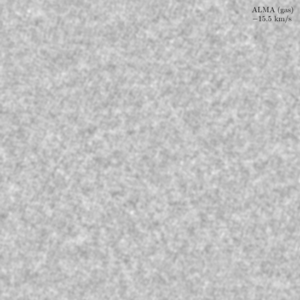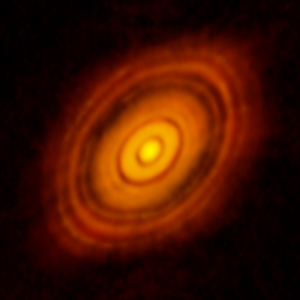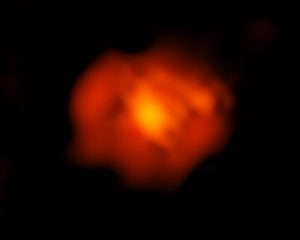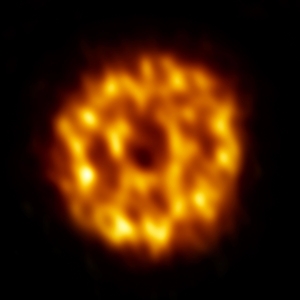Visualizing the ALMA image cube of LL Pegasi. Each frame of the video shows the molecular gas material surrounding LL Pegasi for a different line-of-sight velocity. This velocity, advancing 1 km/s per frame, is given at the top-right corner. The field size is 20,000 times the distance between the Sun and the Earth.


HL Tau: Birth of Planets Revealed in Astonishing Detail
ALMA image of the young star HL Tau and its protoplanetary disk. This best image ever of planet formation reveals multiple rings and gaps that herald the presence of emerging planets as they sweep their orbits clear of dust and gas.

The Dawn of a New Era for Supernova 1987A
Astronomers combined observations from three different observatories to produce this colorful, multiwavelength image of the intricate remains of Supernova 1987A.The red color shows newly formed dust in the center of the supernova remnant, taken at submillimeter wavelengths by the Atacama Large Millimeter/submillimeter Array (ALMA) telescope in Chile.The green and blue hues reveal where the expanding shock wave from the exploded star is colliding with a ring of material around the supernova. The green represents the glow of visible light, captured by NASA’s Hubble Space Telescope. The blue color reveals the hottest gas and is based on data from NASA’s Chandra X-ray Observatory.The ring was initially made to glow by the flash of light from the original explosion. Over subsequent years the ring material has brightened considerably as the explosion’s shock wave slams into it.Supernova 1987A resides 163,000 light-years away in the Large Magellanic Cloud, where a firestorm of star birth is taking place.The ALMA, Hubble, and Chandra images at the bottom of the graphic were used to make up the multiwavelength view.

Supernova 1987A in Submillimeter
This is an image of the intricate remains of Supernova 1987A taken in submillimeter wavelengths by the Atacama Large Millimeter/submillimeter Array (ALMA) telescope in Chile. The red color shows newly formed dust in the center of the supernova remnant.

ALMA image of the dust surrounding the star HD 107146
ALMA image of the dust surrounding the star HD 107146. Dust in the outer reaches of the disk is thicker than in the inner regions, suggesting that a swarm of Pluto-size planetesimals is causing smaller objects to smash together. The dark ring-like structure in the middle portion of the disk may be evidence of a gap where a planet is sweeping its orbit clear of dust.

Black-Hole-Powered Jets Forge Fuel for Star Formation
Composite image showing how powerful radio jets from the supermassive black hole at the center of a galaxy in the Phoenix Cluster inflated huge “bubbles” in the hot, ionized gas surrounding the galaxy (the cavities inside the blue region imaged by NASA’s Chandra X-ray observatory). Hugging the outside of these bubbles, ALMA discovered an unexpected trove of cold gas, the fuel for star formation (red). The background image is from the Hubble Space Telescope.





